You'll find seven natural methods to preserve herbs in wine while maintaining their fresh flavors. Try the traditional cold infusion method for delicate herbs, keeping them in wine for up to 14 days. Hot steeping works well for tougher herbs like rosemary and thyme. Fresh herb infusion offers a cost-effective approach using inexpensive wines as your base. You can also dry herbs first through air drying, oven drying, or using a dehydrator. Store your infused wines in mason jars, maintain proper temperature control, and use wine stoppers for preservation. For ideal aging and clarity, consider multiple racking sessions. These natural techniques are just the beginning of your herb-infused wine journey.
Traditional Cold Infusion Method
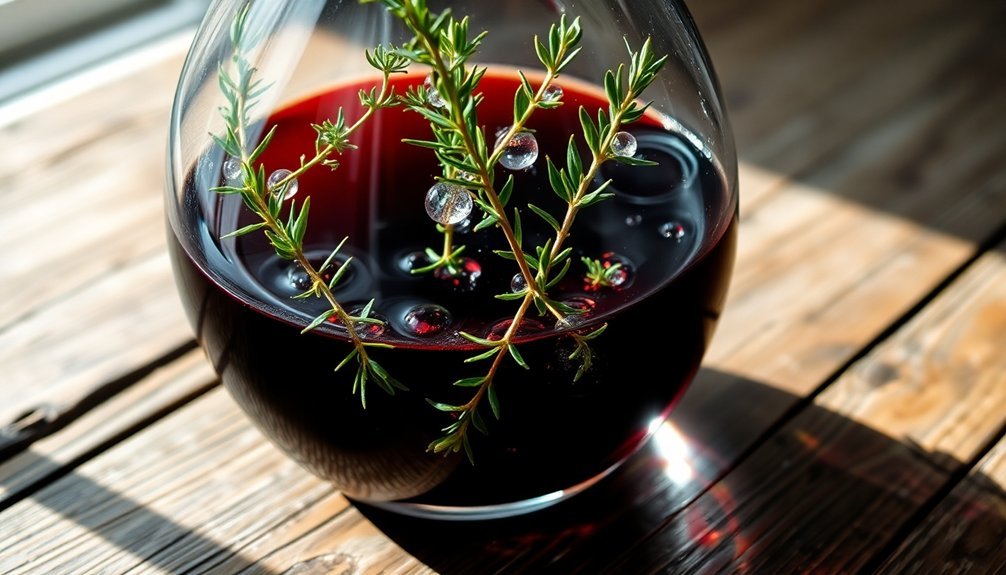
When you're satisfied with the taste, strain the herbs from the wine thoroughly.
You can store your infused wine in the refrigerator or a cool, dark place, but plan to consume it within two weeks of straining to enjoy the best quality and flavor. For optimal results, perform daily taste testing during the 5-14 day infusion period.
Hot Steeping Process
Through the hot steeping process, you'll effectively extract flavors from tougher herbs and dried materials that don't respond well to cold infusion. This method works particularly well with robust herbs like rosemary, sage, and thyme, as well as roots, stems, and dried berries. The heated infusion method typically requires a two-week steeping period for the best results.
You'll want to avoid using delicate herbs, as the heat can destroy their volatile flavors.
To begin, add your chosen herbs to water as it heats on the stovetop. If you're making herbal vinegar, heat the water to 180 degrees Fahrenheit. For wine preparations, bring the water to a boil, then remove it from heat.
While vinegar doesn't require additional steeping time at this stage, wine mixtures need 10 minutes to an hour of steeping time to fully extract the herbal flavors.
Once you've strained your herbal tea, you can incorporate it into your wine mixture. Make sure to cool the blend to room temperature (100-105 degrees Fahrenheit) before adding yeast to prevent shock.
Don't forget to leave adequate space in your fermenter and install an airlock to protect your mixture while allowing gases to escape during fermentation.
Fresh Herb Wine Infusion
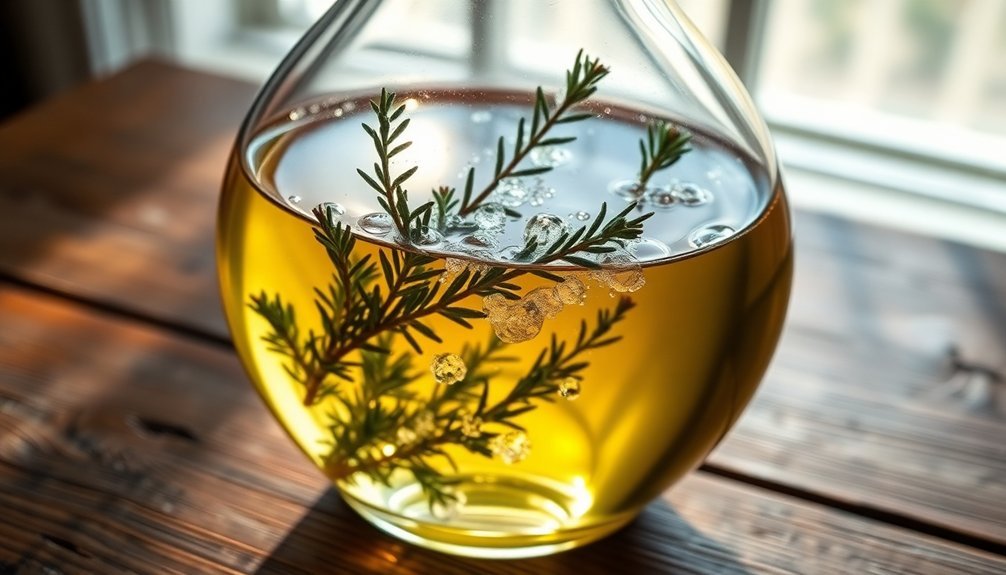
When making herb-infused wine, you'll want to choose sturdy herbs like rosemary, sage, and thyme that can withstand longer steeping times while maintaining their flavor profile.
This simple infusion method provides a cost-effective party option when using inexpensive wines as your base.
You can steep your chosen herbs in wine for anywhere from overnight to 14 days, depending on how strong you'd like the infusion to be.
Keep checking the flavor regularly during the infusion process, and once you're satisfied, strain out the herbs before storing your infused wine in the refrigerator.
Herb Selection For Wine
Selecting the right herbs for wine infusion can transform an ordinary bottle into a personalized, aromatic creation. When working with white wine, you'll want to focus on lighter, brighter herbs like lemon balm, basil, and mint. These herbs complement the wine's natural crispness while adding revitalizing notes.
Don't forget to take into account lemon zest, which can enhance the citrus characteristics already present in many white wines.
For red wines, you'll need more robust herbs to match their fuller body. Oregano, sage, and thyme work exceptionally well, adding savory depth to the wine's existing flavors.
Rosemary's versatility makes it suitable for both red and white wines, contributing a distinctive pine-like aroma.
You can also experiment with fruit and herb combinations. Try pairing lemon with rosemary for a classic blend, or combine berries with basil for a sangria-style infusion.
If you're interested in traditional combinations, look to historical pairings like coriander, which ancient Egyptians used in their wine preparations. Mint and sage have also been used for centuries in wine-based remedies, offering both flavor and traditional medicinal benefits.
Steeping Time And Methods
Once you've chosen your perfect herb combinations, mastering the steeping process will guarantee your wine infusion reaches its full capacity.
You'll need to steep your herbs for a minimum of 12 hours, though the ideal infusion period ranges from 1 to 3 days for subtle flavors and up to two weeks for stronger results. Monitor your infusion daily to achieve your desired taste.
Before you begin, make certain all your equipment is clean and sanitized. Add your cleaned and dried herbs directly to the wine bottle, making sure to remove any white pith from citrus peels to prevent bitterness.
You can use either fresh or dried herbs, though fresh ones typically provide better results. Seal the bottle tightly and store it in a cool, dark place or your refrigerator during the steeping process.
Don't forget to shake the bottle daily to enhance the infusion. Once you've reached your desired flavor, strain out the herbs before serving.
You can store your infused wine for up to two weeks in the refrigerator. For aesthetic appeal, you might want to leave a few herbs in the bottle, but be sure to strain most of them out to prevent over-infusion.
Dried Herb Preservation Technique
Dried herb preservation techniques offer reliable ways to extend nature's bounty throughout the year. You'll find three effective methods to dry your herbs: air drying, oven drying, and using a dehydrator.
For air drying, you'll want to bundle your herbs at the stems and hang them upside down in a well-ventilated, dimly lit area. This traditional method takes about two weeks, but it's gentle on the herbs.
If you're short on time, you can use your oven by setting it to its lowest temperature (around 170°F). Place the herbs in a single layer and leave the door slightly ajar – they'll be ready in 2-4 hours.
The dehydrator method offers precise temperature control at 95°F, taking 1-4 hours to complete. You'll know your herbs are properly dried when they're crisp and break easily.
Once dried, crumble your herbs and store them in airtight glass containers. Don't forget to label them with the herb type and date.
When stored in a cool, dark place, they'll last up to a year. Remember, dried herbs are 3-4 times more potent than fresh ones, so adjust your recipes accordingly.
Fruit and Herb Combinations
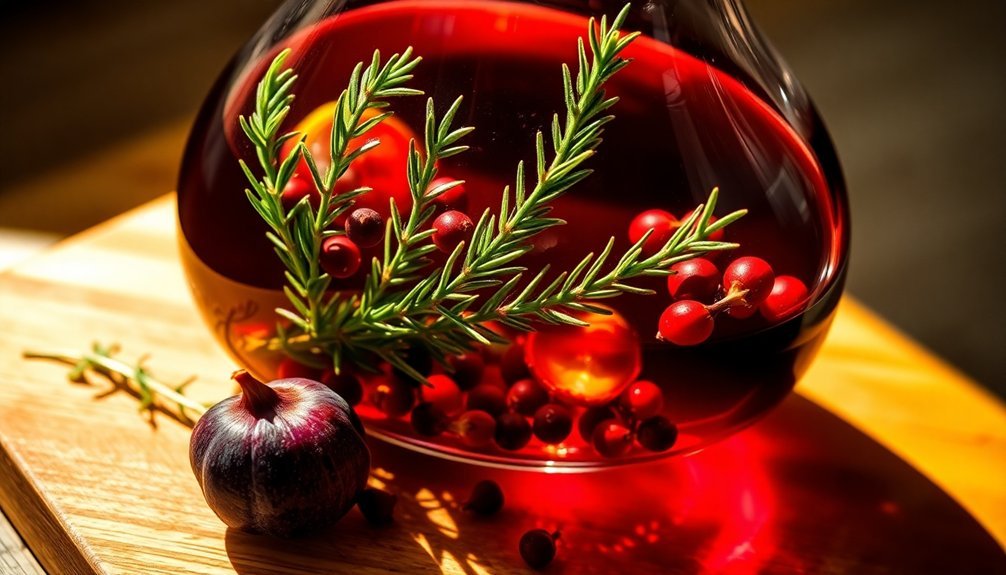
Fresh fruits and aromatic herbs create magical flavor combinations when paired thoughtfully. When you're preserving herbs in wine, you'll want to choose fruits that complement both the herbs and the wine's natural characteristics. Consider using citrus zest from lemons or oranges alongside fresh herbs like basil or mint for a bright, vibrant infusion.
| Fruit | Herb | Wine Type |
|---|---|---|
| Lemon | Basil | White |
| Orange | Rosemary | Red |
| Strawberry | Mint | Rosé |
| Peach | Thyme | White |
| Blackberry | Sage | Red |
You'll achieve the best results by adding your chosen fruit and herb combinations to the wine at the start of the preservation process. Remove the fruit zest carefully with a vegetable peeler, avoiding the bitter white pith. When combining multiple elements, start with small amounts and adjust according to your taste preferences. You can store your infusion in the refrigerator for several days while the flavors develop. Remember to strain out the fruits and herbs once you've reached your desired flavor intensity. For long-term storage, you'll need to rack the wine regularly until it's clear and stable.
Mason Jar Wine Storage
Storing wine properly in mason jars provides an effective solution for preserving opened bottles. You'll want to select a jar size that matches your remaining wine volume, ensuring you fill it completely to minimize air space. When transferring the wine, make sure to seal the jar tightly with its screw-on cap to prevent oxidation.
Once you've transferred your wine, place the mason jar immediately in your refrigerator. The cool temperature, ideally between 51°F-59°F, will slow down the aging process and help maintain the wine's quality. If you're storing red wine, don't worry about the chilling – you can always warm it up before serving by running the jar under lukewarm water.
To keep track of your stored wines, label each jar with the wine type and date. You'll find this method particularly effective because mason jars are readily available and easy to clean.
Remember to keep your stored wine away from direct sunlight, even in the fridge. While wine stoppers and vacuum systems can help preserve opened bottles, using a properly sized mason jar offers a simple, effective solution for maintaining your wine's freshness and flavor.
Long-Term Aging Solutions
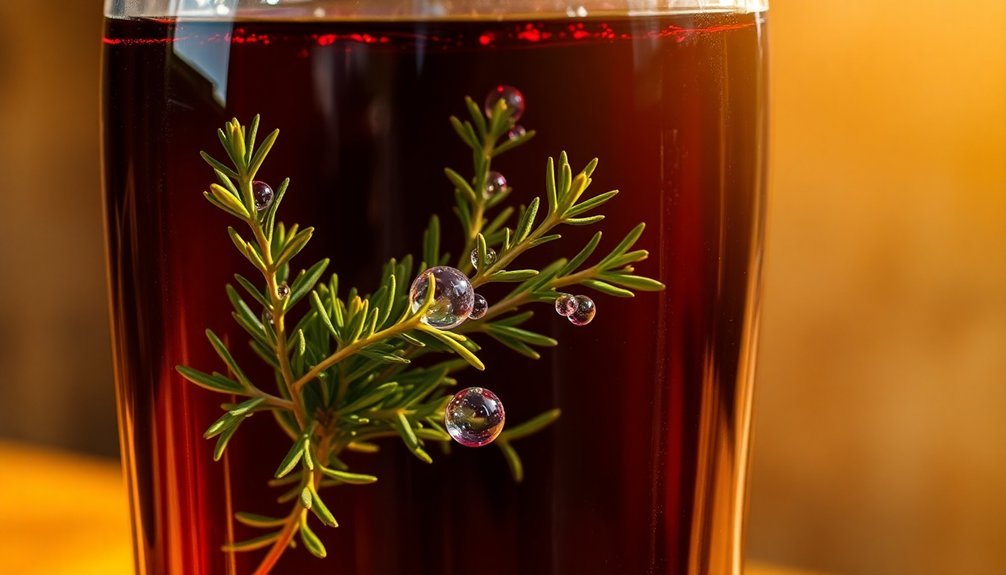
Successful long-term aging of herbal wine requires careful attention to fermentation and storage conditions. You'll need to monitor the fermentation process closely using an airlock and guarantee the bubbling starts within the first hour. Once fermentation begins, store your wine in a cool, dark location where temperatures remain stable.
| Aging Phase | Duration | Key Requirements |
|---|---|---|
| Initial Fermentation | 2 weeks – several months | Cool, dark place; regular airlock monitoring |
| Racking Process | Multiple sessions | Clear liquid; minimal sediment |
| Bottle Aging | 6 months – 1 year | Consistent temperature; no direct sunlight |
During the aging process, you'll want to rack your wine multiple times until it's completely clear. This process helps remove sediment and improves the final product's quality. Label each bottle with the date and herb combination you've used to track your wine's development. As your wine ages, you'll notice the color may darken and the flavors will become more complex. Keep the bottles in airtight containers to prevent oxidation, and avoid moving them unnecessarily. The success of your long-term aging depends largely on maintaining consistent storage conditions throughout the entire process.
Frequently Asked Questions
Can Wild-Foraged Herbs Be Safely Used in Wine Making?
You can safely use wild-foraged herbs in winemaking if you're absolutely certain of plant identification, properly clean them, and follow sanitary practices. Always consult experts or reliable guides to avoid dangerous mistakes.
How Does Alcohol Content Affect the Preservation of Medicinal Properties?
You'll find that higher alcohol content better preserves medicinal properties by preventing bacterial growth and maintaining active compounds. A minimum of 25% alcohol guarantees ideal preservation of your herbs' therapeutic benefits.
What Signs Indicate That an Herbal Wine Infusion Has Gone Bad?
You'll know your herbal wine infusion has spoiled if you notice cloudiness, floating particles, unusual odors, off-putting tastes, slimy substances, mold growth, or strange discoloration. Trust your senses when checking for spoilage.
Is It Necessary to Sterilize Fresh Herbs Before Adding to Wine?
Yes, you'll need to sterilize fresh herbs before adding them to wine. It prevents harmful bacteria, guarantees proper fermentation, and maintains the wine's quality. You can use hot water baths for sterilization.
Can Homemade Herbal Wines Be Used for Cooking and Marinades?
Yes, you can absolutely use homemade herbal wines for cooking and marinades. They'll add complex flavors to your dishes, whether you're marinating meats, making sauces, or cooking grains and vegetables.
In Summary
You've now learned seven natural methods to preserve your favorite herbs in wine. Whether you're using the cold infusion technique or trying the fruit and herb combinations, you'll find these preservation methods both practical and rewarding. Don't forget to properly store your infusions in mason jars and monitor them during the aging process. With these techniques, you'll enjoy your herb-infused wines for months to come.

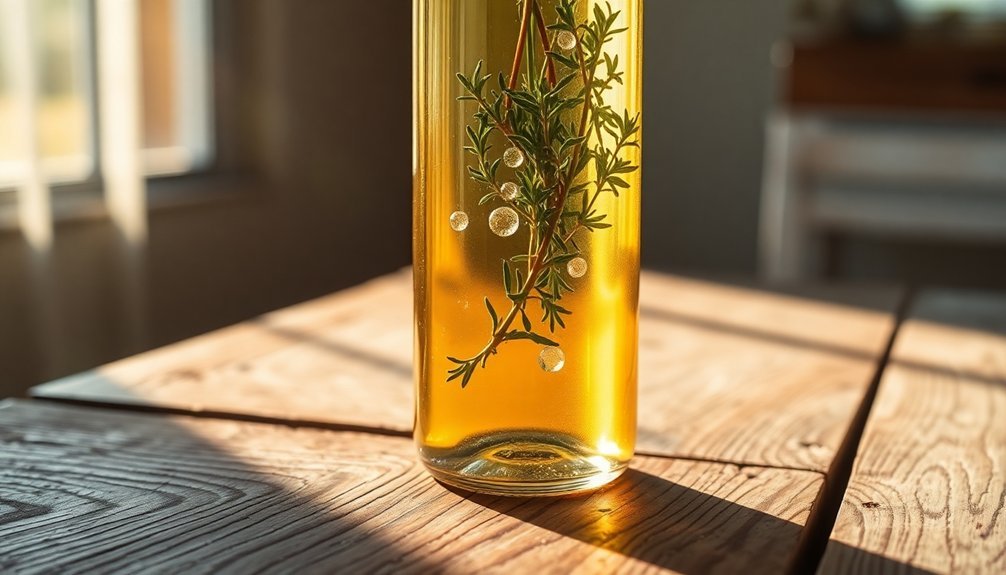



Leave a Reply